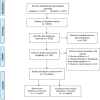Filarial worms: a systematic review and meta-analysis of diversity in animals from Iran with emphasis on human cases
- PMID: 32249728
- PMCID: PMC10317688
- DOI: 10.1017/S003118202000058X
Filarial worms: a systematic review and meta-analysis of diversity in animals from Iran with emphasis on human cases
Abstract
Current systematic review and meta-analysis demonstrate the prevalence reports of filariasis in animals in Iran along with human cases. Studies were screened, relevant papers were selected and the random-effect model was used by forest plot with 95% confidence interval (CI). Of 17 records of human case-reports, particularly from Khuzestan province (5 cases), Dirofilaria repens was the most detected parasite (10 cases) with higher involvement of the right eye (7 cases) than other organs. Eleven animal species were reported to be parasitised by filarioids in Iran. The prevalence of Dirofilaria immitis in canids was 14.69% (95% CI: 10.33-19.67), with highest rates (20.92%; 95% CI: 13.84-29.03) in free-ranging dogs. Male (10.07%; 95% CI: 5.10-16.47) and more than 1-year old (20.77%; 95% CI: 8.66-36.42) dogs were more likely to be found infected. The frequency of other filarioids of zoonotic interest was: Acanthocheilonema reconditum in dogs 2.15% (95% CI: 0.71-4.33), Dipetalonema evansi in camels 10.16% (95% CI: 4.73-17.34), Onchocerca cervicalis in horses 3.63% (95% CI: 1.44-6.75%) and Onchocerca fasciata 16.57% (95% CI: 10.12-24.24%) in camels. Still, our knowledge on parasitic filariae in Iran is limited and more investigation is needed in both human and animal populations.
Keywords: Diversity; Filarioids; Iran; meta-analysis; systematic review.
Figures



Similar articles
-
Canine filarial infections in an area of Central Italy (Tuscany-Latium border) historically free from the disease.Vet Parasitol Reg Stud Reports. 2020 Apr;20:100404. doi: 10.1016/j.vprsr.2020.100404. Epub 2020 Mar 26. Vet Parasitol Reg Stud Reports. 2020. PMID: 32448535
-
Filarial Nematodes in Dogs from the Northeast Region of Brazil.Acta Parasitol. 2024 Jun;69(2):1115-1121. doi: 10.1007/s11686-024-00834-x. Epub 2024 Mar 27. Acta Parasitol. 2024. PMID: 38536612
-
Molecular detection of Leishmania infantum, filariae and Wolbachia spp. in dogs from southern Portugal.Parasit Vectors. 2016 May 10;9(1):170. doi: 10.1186/s13071-016-1452-2. Parasit Vectors. 2016. PMID: 27160085 Free PMC article.
-
The global status of Dirofilaria immitis in dogs: a systematic review and meta-analysis based on published articles.Res Vet Sci. 2020 Aug;131:104-116. doi: 10.1016/j.rvsc.2020.04.002. Epub 2020 Apr 10. Res Vet Sci. 2020. PMID: 32330696
-
Dirofilaria in Humans, Dogs, and Vectors in Austria (1978-2014)-From Imported Pathogens to the Endemicity of Dirofilaria repens.PLoS Negl Trop Dis. 2016 May 19;10(5):e0004547. doi: 10.1371/journal.pntd.0004547. eCollection 2016 May. PLoS Negl Trop Dis. 2016. PMID: 27196049 Free PMC article. Review.
Cited by
-
Prevalence of urinary schistosomiasis in women: a systematic review and meta-analysis of recently published literature (2016-2020).Trop Med Health. 2022 Jan 29;50(1):12. doi: 10.1186/s41182-022-00402-x. Trop Med Health. 2022. PMID: 35093180 Free PMC article. Review.
-
Lymphatic filariasis in Asia: a systematic review and meta-analysis.Parasitol Res. 2021 Feb;120(2):411-422. doi: 10.1007/s00436-020-06991-y. Epub 2021 Jan 8. Parasitol Res. 2021. PMID: 33415391 Free PMC article.
-
An investigation of the prevalence of equine filariosis in North and Northeast of Iran.J Parasit Dis. 2024 Mar;48(1):163-167. doi: 10.1007/s12639-023-01643-1. Epub 2024 Jan 19. J Parasit Dis. 2024. PMID: 38440766 Free PMC article.
-
Global distribution of Echinococcus granulosus genotypes in domestic and wild canids: a systematic review and meta-analysis.Parasitology. 2022 Aug;149(9):1147-1159. doi: 10.1017/S0031182022000658. Epub 2022 May 20. Parasitology. 2022. PMID: 35591776 Free PMC article.
-
Geographic Spatial Distribution Patterns of Dirofilaria immitis and Brugia pahangi Infection in Community Dogs in Chiang Mai, Thailand.Animals (Basel). 2020 Dec 26;11(1):33. doi: 10.3390/ani11010033. Animals (Basel). 2020. PMID: 33375359 Free PMC article.
References
-
- Ahmad R and Srivastava AK (2007) Biochemical composition and metabolic pathways of filarial worms Setaria cervi: search for new antifilarial agents. Journal of Helminthology 81, 261–280. - PubMed
-
- Akhtardanesh B, Radfar MH, Voosough D and Darijani N (2011) Seroprevalence of canine heartworm disease in Kerman, southeastern Iran. Comparative Clinical Pathology 20, 573–577.
-
- Alborzi A, Mosallanejad B, Najafabadi M and Nikpoor Z (2010) Infestation of heartworm (Dirofilaria immitis) in a cat in Ahvaz City: a case report. Journal of Veterinary Research 65, 255–271.
-
- Alho AM, Meireles J, Schnyder M, Cardoso L, Belo S, Deplazes P and de Carvalho LM (2018) Dirofilaria immitis and Angiostrongylus vasorum: the current situation of two major canine heartworms in Portugal. Veterinary Parasitology 252, 120–126. - PubMed
-
- Anderson RC (2000) Nematode Parasites of Vertebrates: Their Development and Transmission. UK: Cabi.
Publication types
MeSH terms
LinkOut - more resources
Full Text Sources

